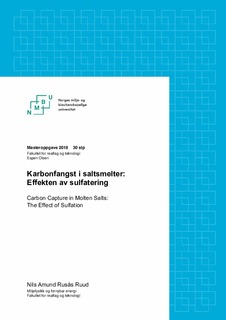| dc.contributor.advisor | Olsen, Espen | |
| dc.contributor.advisor | Nygård, Heidi | |
| dc.contributor.author | Ruud, Nils Amund Rusås | |
| dc.date.accessioned | 2018-11-12T09:36:21Z | |
| dc.date.available | 2018-11-12T09:36:21Z | |
| dc.date.issued | 2018 | |
| dc.identifier.uri | http://hdl.handle.net/11250/2571950 | |
| dc.description.abstract | For å oppnå dype kutt i klimagassutslippene fra stasjonære punktkilder som industri og fossil kraftproduksjon, vil karbonfangst og -lagring (CCS) være nødvending. Per i dag er karbonfangst relativt dyrt og ny teknologi kan være løsningen. Karbonfangst i saltmelter (CCMS) er en slik ny karbonfangstteknologi. I CCMS utnyttes den reversible reaksjonen mellom kalsiumoksid (CaO) og karbondioksid (CO2) som danner kalsiumkarbonat (CaCO3). CCMS har vist svært gode egenskaper for karbonfangst med simulerte røykgasser på labskala, men før en eventuell oppskalering må flere elementer fra reelle avgasser studeres. I denne oppgaven rettes fokuset mot svoveldioksid (SO2), samt at oksygen (O2) er tilstede i avgassen. I denne masteroppgaven er det gjennomført forsøk for å undersøke indirekte sulfatering av CaO og direkte sulfatering CaCO3 i en eutektisk blanding av kalsiumklorid (CaCl2) og kalsiumfluorid (CaF2). Avgassen inneholdt 0,5% SO2 og 3% O2. I tillegg er karbonfangst med forskjellige mengder SO2 i avgassen opp mot 0,5% utført. Innholdet i avgassen ut av smelten ble målt med FTIR. Hypotesen var at indirekte og direkte sulfatering ville forekomme, og at SO2 vil hemme karbonfangst. Dette fordi reaksjonene mellom SO2 og CaO/CaCO3 er termodynamisk favorisert over karbonering av CaO. Resultatene tilsier at både direkte og indirekte sulfatering forekommer, samt at karbonfangst blir hemmet etter nivå av SO2 i avgassen. Under blindforsøk uten sorbent og uten salt ble lavere SO2-nivåer enn forventet målt ut av reaktoren. Dette tyder på reaktivitet mellom SO2 og konstruksjonsmaterialene for reaktoren. Det er i tillegg funnet konkrete indikasjoner på at aktivitetskoeffisienten til CaO i CCMS er høyere enn i fast fase. Under antagelsen om at aktivitetskoeffisienten til CaCO3 er 1 vil koeffisienten til CaO være omtrent 5, det er dog stor usikkerhet knyttet til dette. Til videre arbeid er det interessant å undersøke hvordan CCMS håndterer en reell avgass eller om CCMS kan brukes til karbonfangst direkte fra luft. | nb_NO |
| dc.description.abstract | In order to achieve deep cuts in greenhouse gas emissions from stationary point sources such as industry and fossil power generation, carbon capture and storage (CCS) will be a necessity. As oftoday, CCS is relatively expensive and newtechnology could be a solution. Carbon Capture in Molten Salts (CCMS) is such a new technology. In CCMS, the reversible reaction between calcium oxide (CaO) and carbon dioxide (CO2) that forms calcium carbonate (CaCO3) is utilized. CCMS has demonstrated promising properties for carbon capture with simulated flue gases on the lab scale, but before scaling up, several elements from real flue gases must be studied. In this thesis, the focus is on sulfur dioxide (SO2), oxygen (O2) is also present in the flue gas. In this master thesis, experiments have been conducted to investigate indirect sulfation of CaO and direct sulfation of CaCO3 in an eutectic mixture of calcium chloride (CaCl2) and calcium fluoride (CaF2). The flue gases contained 0.5% SO2 and 3% O2. In addition, carbon capture with levels of SO2 up to 0.5% has been performed. The content of the exhaust gas from the melt was analyzed by FTIR. The hypothesis was that indirect and direct sulfation would occur and that SO2 would inhibit carbon capture. This is because the reactions between SO2 and CaO/CaCO3 are thermodynamically favoured over carbonation of CaO. The results indicate that both direct and indirect sulfation occurs and that carbon capture is inhibited in accordance with the level of SO2 in the flue gas. In experiments without sorbent and without salt, the SO2 level measured was lower than expected. This might be due to reactivity between SO2 and the structural materials in the reactor. In addition, concrete indications have been found that the activity coefficient of CaO in CCMS is higher than in the solid phase. Under the assumption that the activity coefficient of CaCO3 is 1, the coefficient of CaO will be about 5, however, there is great uncertainty attached to this. In further work, it would be interesting to investigate how CCMS handles a real exhaust gas or whether CCMS can be used for carbon capture directly from air. | nb_NO |
| dc.language.iso | nob | nb_NO |
| dc.publisher | Norwegian University of Life Sciences, Ås | nb_NO |
| dc.rights | Attribution-NonCommercial-NoDerivatives 4.0 Internasjonal | * |
| dc.rights.uri | http://creativecommons.org/licenses/by-nc-nd/4.0/deed.no | * |
| dc.subject | Karbonfangst | nb_NO |
| dc.subject | Saltsmelte | nb_NO |
| dc.subject | Røykgassavsvovling | nb_NO |
| dc.subject | Sulfatering | nb_NO |
| dc.title | Karbonfangst i saltsmelter : effekten av sulfatering | nb_NO |
| dc.title.alternative | Carbon capture in molten salts : the effect of sulfation | nb_NO |
| dc.type | Master thesis | nb_NO |
| dc.description.version | submittedVersion | nb_NO |
| dc.subject.nsi | VDP::Teknologi: 500 | nb_NO |
| dc.relation.project | Forskningsrådet: 233804 | nb_NO |
| dc.description.localcode | M-MF | nb_NO |

